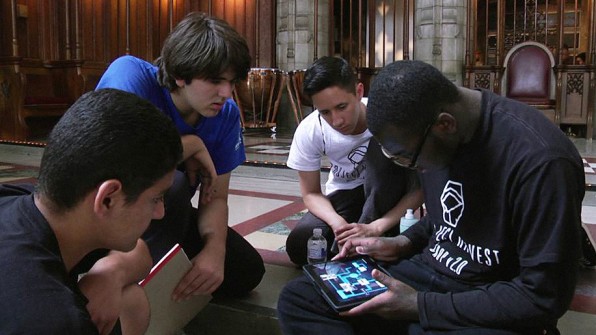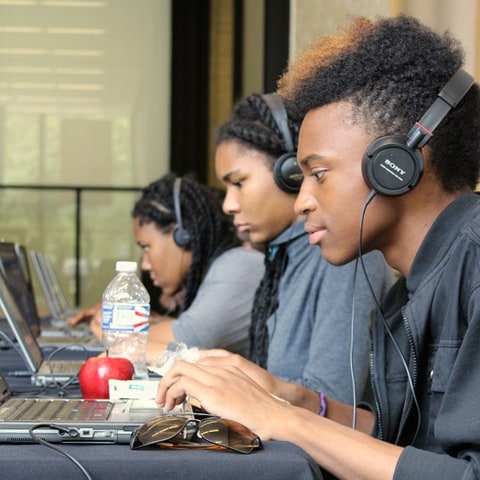best free alternative to after effects
In a lab at the University of Chicago, a group of high school students simultaneously lives in two worlds. One is reality–which for too many in Chicago means gang violence, high rates of teen pregnancy, and the feeling they're trapped by circumstance.
The other is an alternate reality that empowers them to see possibilities beyond their neighborhood.
The Game Changer Chicago Design Lab uses digital gameplay and design to engage urban teens with social and health issues in a safe environment. During the initiative's flagship summer program, students spend three weeks playing an alternate-reality game designed by the Game Changer team before developing their own projects based on situations they encounter in their neighborhoods.

As they explore social issues, they also learn to code, design, and problem-solve–skills that expose them to and prepare them for science and technology careers.
"They're not just critiquing the world as it currently is," said cofounder Patrick Jagoda, an English and new media professor at the university. "They literally live in a different world that's a microcosm they can experiment with and try on."
Jagoda and Melissa Gilliam, a pediatric and adolescent gynecologist, began collaborating on socially focused digital storytelling projects in 2010. As a doctor, Gilliam treated health problems once they got to a clinical setting. But she wanted to start addressing the social issues that left teens vulnerable to consequences such as unplanned pregnancy and STDs.
Games, she believes, engage teens with difficult topics on their terms.
"Games are fundamentally a social form," Jagoda said. "They're a really wonderful way to break down social and cultural barriers." He and Gilliam brought together a team that includes graduate and undergraduate students from several area universities to help design games and run the program.
Game Changer's board game Hexacago, for example, examines neighborhood health disparities that people assume depend on individual behavior. Students learn in one scenario that STD rates are much higher in some neighborhoods than others not because people take more risks–the population actually used more condoms–but because there are fewer clinics.
"We demonstrate in a board game that the way disease spreads has to do with access to health care," Gilliam said. "We give them agency rather than making them victims. It becomes quite empowering that this thing used to stigmatize you is actually very different than you thought it was."
Most of Game Changer's participants, who range in age from 12-20, attend high schools on Chicago's chronically underserved south and west sides. More than 95% of the students are African-American or Latino, and 70% are male.
Taking social chances has high stakes in the neighborhoods where most of the students live. Alternate-reality games remove the risk. "We all know that we learn more from failures than successes," Gilliam said. "We create a place where people learn how to fail and learn to pick themselves up after failure."
This summer, students worked to prevent a global climate catastrophe through role-playing, code decryption, and scavenger hunts. And a tablet-based game led them through the university's campus so they could start to feel a sense of ownership over a place many wouldn't feel comfortable walking into under other circumstances.
The challenge became more personal when students designed their own games. One team invited players into a room, hung an ultrasound on the wall, and handed them a positive pregnancy test. In the next room, they took an extremely hard test burdened with the knowledge that one more failure would get them kicked out of school.
Game Changers' team takes the lessons further by introducing not just an issue, like unplanned pregnancy, but also the doctors who treat pregnant teens–teaching kids that they can choose a career that's part of the solution for their communities' challenges.
"When people start exposing you to all the things you can do, it takes painful social issues and turns them into something where there are new possibilities," Gilliam said.

Parents report significant changes in their children's behavior during the course of the program, lab director Ashlyn Sparrow said. One mother told her his son would come home and continue to role-play as if he were still in the game world.
"Another mother told me she couldn't believe her child was actually communicating," she said. "She used to come home and grunt a little. Now she came home talking about science and technology."
The team collects data around the students and interviews them six and 12 months out to analyze the continued impact. They're experimenting with a mentorship program to provide ongoing support.
Eventually, Gilliam said they hope to develop games that can be packaged and played in classrooms, community organizations, and homes across the country.
"There's that term of games as 'possibility space,'" Gilliam said. "We take that very seriously, that they can target behavior but also open up all these possibilities. [Students say] 'I was so isolated, and I found something wonderful.' People have a new lease on life. It's not only possible; it should be done."
best free alternative to after effects
Source: https://www.fastcompany.com/3036787/the-alternate-reality-games-that-teach-kids-the-cause-and-effect-of-their-circums
Posted by: hookerlikedy.blogspot.com

0 Response to "best free alternative to after effects"
Post a Comment